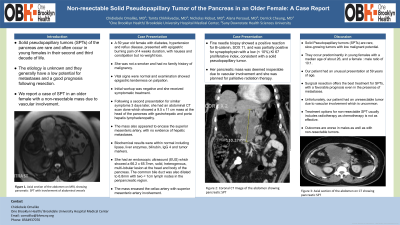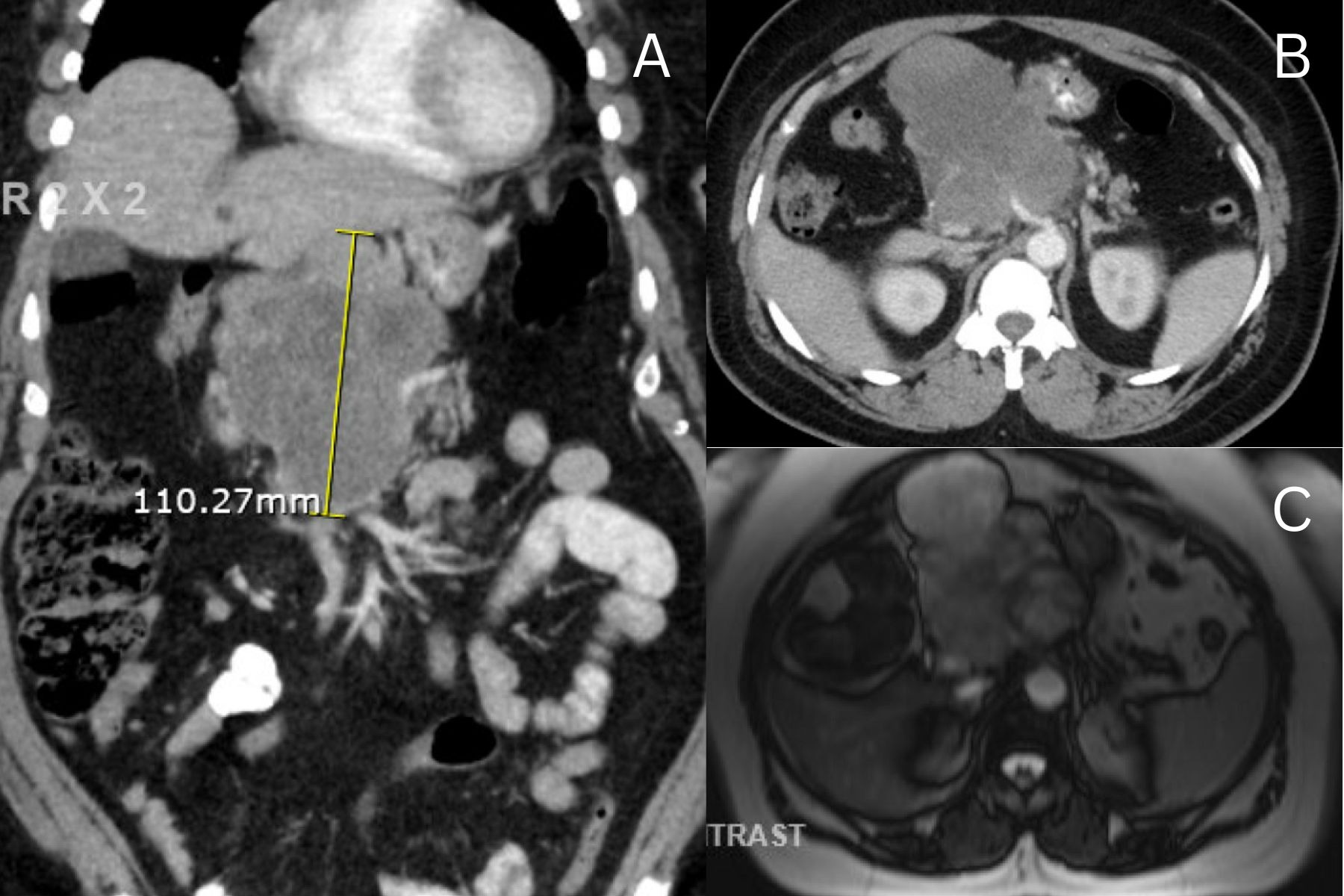Monday Poster Session
Category: Biliary/Pancreas
P1494 - Non-Resectable Solid Pseudopapillary Tumor of the Pancreas in an Older Female: A Case Report
Monday, October 23, 2023
10:30 AM - 4:15 PM PT
Location: Exhibit Hall

Has Audio

Chidiebele E. Omaliko, MD
One Brooklyn Health-Brookdale University Hospital Medical Center
Brooklyn, NY
Presenting Author(s)
Chidiebele Omaliko, MD1, Tamta Chkhikvadze, MD2, Nicholas Ridout, MD3, Alana Persaud, MD3, Derrick Cheung, MD4
1One Brooklyn Health-Brookdale University Hospital Medical Center, Brooklyn, NY; 2SUNY Downstate Health Sciences University, Brooklyn, NY; 3SUNY Downstate Medical Center, Brooklyn, NY; 4One Brooklyn Health, Brooklyn, NY
Introduction: Solid pseudopapillary tumors (SPTs) of the pancreas are rare and often occur in young females in their second and third decade of life. The etiology is unknown and they generally have a low potential for metastases and a good prognosis following resection. We report a case of SPT in an older female with a non-resectable mass due to vascular involvement.
Case Description/Methods: A 59 year old female with diabetes, hypertension and reflux disease, presented with epigastric burning pain of 4 weeks duration, with nausea and constipation but no weight loss. She was not a smoker and had no family history of malignancy. Vital signs were normal and examination showed epigastric tenderness on palpation. Initial workup was negative and she received symptomatic treatment. Following a second presentation for similar symptoms 3 days later, she had an abdominal CT scan done which showed a 9.5 x 11 cm mass at the head of the pancreas with gastrohepatic and porta hepatis lymphadenopathy. The mass also appeared to encase the superior mesenteric artery, with no evidence of hepatic metastases. Biochemical results were within normal including lipase, liver enzymes, bilirubin, IgG 4 and tumor markers. She had an endoscopic ultrasound (EUS) which showed a 66.2 x 65.7mm, solid, heterogenous, multi-lobular lesion at the head and body of the pancreas. The common bile duct was also dilated to 6.8mm with two < 1cm lymph nodes in the peripancreatic region. The mass encased the celiac artery with superior mesenteric artery involvement. Fine needle biopsy showed a positive reaction for B-catenin, SOX 11, and was partially positive for synaptophysin with a low (< 10%) KI 67 proliferative index, consistent with a solid pseudopapillary tumor. Her pancreatic mass was deemed inoperable due to vascular involvement and she was planned for palliative radiation therapy.
Discussion: Solid Pseudopapillary tumors (SPTs) are rare, slow-growing tumors with low malignant potential. They occur predominantly in young females with a median age of about 26, and a female : male ratio of 10:1. Our patient had an unusual presentation at 59 years of age. Surgical resection offers the best treatment for SPTs, with a favorable prognosis even in the presence of metastases. Unfortunately, our patient had an unresectable tumor due to vascular involvement which is uncommon. Treatment options for non-resectable SPT usually includes radiotherapy as chemotherapy is not as effective. Outcomes are worse in males as well as with non-resectable tumors.

Disclosures:
Chidiebele Omaliko, MD1, Tamta Chkhikvadze, MD2, Nicholas Ridout, MD3, Alana Persaud, MD3, Derrick Cheung, MD4. P1494 - Non-Resectable Solid Pseudopapillary Tumor of the Pancreas in an Older Female: A Case Report, ACG 2023 Annual Scientific Meeting Abstracts. Vancouver, BC, Canada: American College of Gastroenterology.
1One Brooklyn Health-Brookdale University Hospital Medical Center, Brooklyn, NY; 2SUNY Downstate Health Sciences University, Brooklyn, NY; 3SUNY Downstate Medical Center, Brooklyn, NY; 4One Brooklyn Health, Brooklyn, NY
Introduction: Solid pseudopapillary tumors (SPTs) of the pancreas are rare and often occur in young females in their second and third decade of life. The etiology is unknown and they generally have a low potential for metastases and a good prognosis following resection. We report a case of SPT in an older female with a non-resectable mass due to vascular involvement.
Case Description/Methods: A 59 year old female with diabetes, hypertension and reflux disease, presented with epigastric burning pain of 4 weeks duration, with nausea and constipation but no weight loss. She was not a smoker and had no family history of malignancy. Vital signs were normal and examination showed epigastric tenderness on palpation. Initial workup was negative and she received symptomatic treatment. Following a second presentation for similar symptoms 3 days later, she had an abdominal CT scan done which showed a 9.5 x 11 cm mass at the head of the pancreas with gastrohepatic and porta hepatis lymphadenopathy. The mass also appeared to encase the superior mesenteric artery, with no evidence of hepatic metastases. Biochemical results were within normal including lipase, liver enzymes, bilirubin, IgG 4 and tumor markers. She had an endoscopic ultrasound (EUS) which showed a 66.2 x 65.7mm, solid, heterogenous, multi-lobular lesion at the head and body of the pancreas. The common bile duct was also dilated to 6.8mm with two < 1cm lymph nodes in the peripancreatic region. The mass encased the celiac artery with superior mesenteric artery involvement. Fine needle biopsy showed a positive reaction for B-catenin, SOX 11, and was partially positive for synaptophysin with a low (< 10%) KI 67 proliferative index, consistent with a solid pseudopapillary tumor. Her pancreatic mass was deemed inoperable due to vascular involvement and she was planned for palliative radiation therapy.
Discussion: Solid Pseudopapillary tumors (SPTs) are rare, slow-growing tumors with low malignant potential. They occur predominantly in young females with a median age of about 26, and a female : male ratio of 10:1. Our patient had an unusual presentation at 59 years of age. Surgical resection offers the best treatment for SPTs, with a favorable prognosis even in the presence of metastases. Unfortunately, our patient had an unresectable tumor due to vascular involvement which is uncommon. Treatment options for non-resectable SPT usually includes radiotherapy as chemotherapy is not as effective. Outcomes are worse in males as well as with non-resectable tumors.

Figure: Figure showing CT Scan (A and B) and MRI (C) Images of Non-resectable Solid Pseudopapillary Tumor of the Pancreas
Disclosures:
Chidiebele Omaliko indicated no relevant financial relationships.
Tamta Chkhikvadze indicated no relevant financial relationships.
Nicholas Ridout indicated no relevant financial relationships.
Alana Persaud indicated no relevant financial relationships.
Derrick Cheung indicated no relevant financial relationships.
Chidiebele Omaliko, MD1, Tamta Chkhikvadze, MD2, Nicholas Ridout, MD3, Alana Persaud, MD3, Derrick Cheung, MD4. P1494 - Non-Resectable Solid Pseudopapillary Tumor of the Pancreas in an Older Female: A Case Report, ACG 2023 Annual Scientific Meeting Abstracts. Vancouver, BC, Canada: American College of Gastroenterology.
